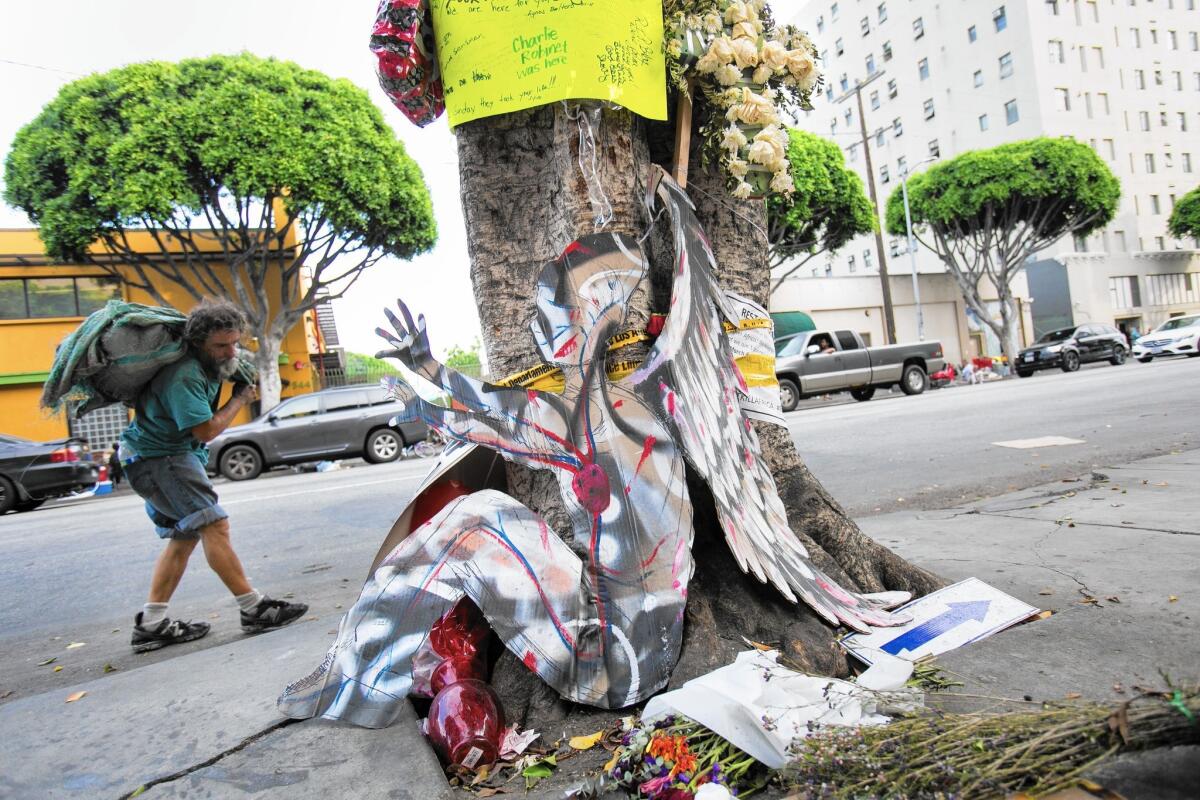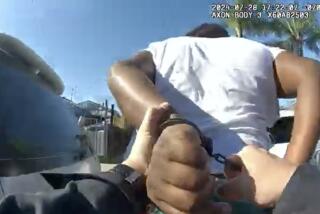LAPD body camera video of skid row shooting raises questions on tactics and training

- Share via
A Los Angeles police officer repeatedly threatened to use a Taser against a homeless man who tried to talk to police before they shot and killed him on skid row, body camera video reviewed by The Times shows.
The officer cut off Charly “Africa” Keunang’s repeated requests to “Let me express myself” after he was ordered to submit to arrest by saying, “You don’t tell me how to do my job” and “We’re going to do this my way,” the video shows.
“You’re going to get tased,” the officer said several times just before Keunang retreated into his sidewalk tent, then came out flailing and died March 1 in a volley of police gunfire. A bystander’s video of the incident was viewed by millions after it was posted online.
Independent policing experts, after reading a transcript of the body camera video provided by The Times, said the officer’s words raised questions about the Los Angeles Police Department’s tactics and training in handling mentally ill and drug- and alcohol-addicted people, especially in the lead-up to highly charged incidents.
They cautioned that it was hard to draw firm conclusions without seeing the video, which would show the officers’ body language, tone of voice and proximity to Keunang.
In the wake of a spate of controversial police violence incidents, departments across the country are examining officers’ tactics before deadly encounters.
Keunang, 43, a Cameroonian immigrant, had been confined to a U.S. mental hospital during a 14-year prison term he served for bank robbery. An autopsy found methamphetamine in his system. Police Chief Charlie Beck said the officers involved in Keunang’s shooting had received the department’s “most extensive mental illness training,” which he described as a 36-hour course.
Seth Stoughton, a University of South Carolina law professor and former police officer who has written about de-escalating law enforcement confrontations, said one officer appeared to have asserted his authority in “a rather aggressive manner.”
“He is issuing commands, making threats and flatly ignoring Mr. Keunang’s attempts to say anything,” Stoughton said. “By trying to earn his cooperation rather than require his compliance, perhaps a tragic situation could have been avoided.”
Los Angeles Police Capt. Jeff Bert declined to discuss the Keunang shooting, but said the officers’ tactics leading up to the death are part of a department investigation.
“The department investigates every aspect of a shooting including events leading up to the use of force,” Bert said.
The body camera video of the Keunang incident, first reported by GQ magazine, came from devices worn by two officers during the confrontation. The recording does not capture key parts of the incident, including whether Keunang grabbed one of the officers’ holstered guns, as the department has contended.
This year, the Police Commission found the fatal shooting of Ezell Ford, 25, a mentally ill black man, out of policy because of flawed police tactics, even though Ford struggled with an officer over control of his holstered gun.
Citing ongoing investigations, the LAPD has refused calls from the American Civil Liberties Union and others to release the body camera footage, which officers viewed before they talked to investigators. The department has said it does not plan on publicly releasing any body camera recordings unless they are part of a criminal or civil court proceeding.
Police said they went to Keunang’s tent in response to a 911 robbery call. The footage begins with Keunang standing quietly outside his tent. “Did you hit him?” an officer asks. The body camera is too far away to pick up Keunang’s response, which lasts about a minute.
When the audio picks up, Keunang is insisting on his right to speak and ignoring officers’ commands to stand against a wall to be handcuffed. Keunang and the officer repeatedly spar over his right to speak and the officer’s intent to use the stun weapon.
After the argument escalates, Keunang goes into his tent, saying, “Leave me alone.”
Another officer says, “You gotta figure out what’s going on. C’mon bro, just relax, OK? Step outside.”
Keunang says, “OK.”
Officers pull the tent open, and the first officer fires the stun gun, the footage shows. Keunang jumps out of the tent spinning and flailing wildly toward the officers with his arms outstretched and palms open wide. Police officials said later that the Taser “was not effective.”
Officers take Keunang to the ground, where a rookie officer, Joshua Volasgis, appears to punch him, according to the bystander’s video.
During the struggle, Volasgis says several times, “He’s got my gun” and “He has my gun.” Volasgis backs away from Keunang and the shots ring out. The gun was still in Volasgis’ holster when the shooting ended.
The LAPD identified those who shot Keunang as Sgt. Chand Syed and Officers Francisco Martinez and Daniel Torres. Which two officers were speaking on the body camera video could not be confirmed.
If the “calmer” officer had taken control, the incident might have had a different outcome, Stoughton said.
NEWSLETTER: Get the day’s top headlines from Times Editor Davan Maharaj >>
The lead-up to a police use of force is especially critical in places like skid row, said Gary T. Klugiewicz, a retired Milwaukee County sheriff’s captain and former head of the American Society of Law Enforcement Trainers.
“A lot of the time it is how you start the dance that sets the tone for when an officer makes a contact,” said Klugiewicz, adding that an officer’s tone and how close he stands to a suspect can be as important as his words.
Since the Keunang shooting, the entire LAPD patrol force has undergone extensive training in de-escalating incidents. Bert said specialized mental-evaluation unit officers have lectured beat cops on the best ways to handle those they believe may have mental health issues.
Stoughton said training is necessary but “there has to be some accountability when officers don’t use their de-escalation training.”
Pete White of the Los Angeles Community Action Network, a skid row advocacy group, said he has seen little change in police tactics in the neighborhood.
“It’s not just a training issue. It’s a culture issue,” White said. “It’s how they see poor folks and people of color, that they have nothing of value to say. And you can’t train away from that.”
[email protected]
Twitter: @geholland
[email protected]
Twitter: @lacrimes
ALSO
Why L.A.’s homeless camp cleanups seem to be futile
Latino immigrants finally getting suburban-style chain stores
Flood-prone Newport Beach is getting ready for El Niño
More to Read
Sign up for Essential California
The most important California stories and recommendations in your inbox every morning.
You may occasionally receive promotional content from the Los Angeles Times.












